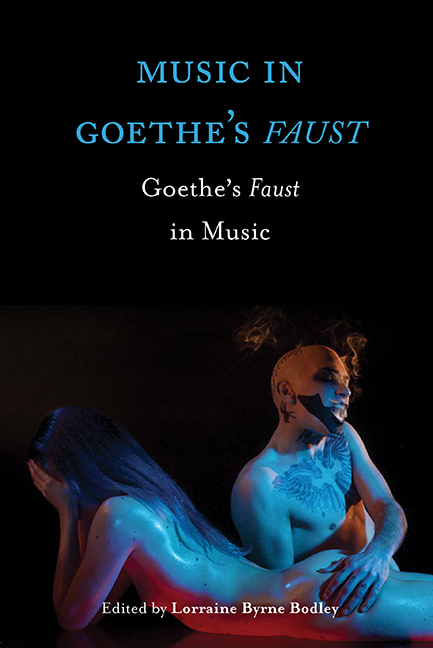Book contents
- Frontmatter
- Dedication
- Contents
- List of Illustrations
- Contributors
- Acknowledgements
- Abbreviations Used in the Notes
- Introduction. Rhapsody and Rebuke: Goethe's Faust in Music
- Part I Goethe's Faust: Content and Context
- Part II Legacies: Goethe's Faust in the Nineteenth Century
- 6 Faust's Schubert: Schubert's Faust
- 7 The Musical Novel as Master-genre: Schumann's Szenen aus Goethes Faust
- 8 The Psychology of Schumann's Faust: Developing the Human Soul
- 9 A Life with Goethe: Wagner's Engagement with Faust in Music and in Words
- 10 Wagner's Ninth: Reading Beethoven with Faust
- 11 Linking Christian and Faustian Utopias: Mahler's Setting of the Schlußszene in his Eighth Symphony
- Part III Topographies: Stagings and Critical Reception
- Part IV New Directions: Recent Productions and Appropriations
- Select Bibliography
- Index
8 - The Psychology of Schumann's Faust: Developing the Human Soul
from Part II - Legacies: Goethe's Faust in the Nineteenth Century
Published online by Cambridge University Press: 30 August 2017
- Frontmatter
- Dedication
- Contents
- List of Illustrations
- Contributors
- Acknowledgements
- Abbreviations Used in the Notes
- Introduction. Rhapsody and Rebuke: Goethe's Faust in Music
- Part I Goethe's Faust: Content and Context
- Part II Legacies: Goethe's Faust in the Nineteenth Century
- 6 Faust's Schubert: Schubert's Faust
- 7 The Musical Novel as Master-genre: Schumann's Szenen aus Goethes Faust
- 8 The Psychology of Schumann's Faust: Developing the Human Soul
- 9 A Life with Goethe: Wagner's Engagement with Faust in Music and in Words
- 10 Wagner's Ninth: Reading Beethoven with Faust
- 11 Linking Christian and Faustian Utopias: Mahler's Setting of the Schlußszene in his Eighth Symphony
- Part III Topographies: Stagings and Critical Reception
- Part IV New Directions: Recent Productions and Appropriations
- Select Bibliography
- Index
Summary
The Unconscious in Faust
Just before his final monologue in Part II, Act V of Goethe's drama, the now blind Faust hears what he imagines to be the sounds of the construction of his urban utopia. Of course what he is actually hearing are the Lemures of Mephistopheles busily digging his grave. To add irony to the scene, Goethe turned (characteristically, for Faust) to a song form. While they work, the Lemures sing a paraphrase of the gravedigger's ditty from Hamlet. The song serves to mock Faust's life and predicament, but their words are seemingly inaudible to Faust beneath the din of their spades. Drawn to the musical implications of the scene (and to Faust's deafness toward it), Robert Schumann chose to set this grotesque and foreboding moment to music in Part II of his oratorio Szenen aus Goethes Faust. Its significance to the composer can be affirmed by the important motivic reference in the Lemures’ chorus that deliberately connects the passage to other key moments in the oratorio both before and after this scene (Example 8.1).
This very motif – a sequence of descending thirds or fourths – can be seen as embodying a problem that persists in the scholarly reception of Schumann's Szenen aus Goethes Faust. Nearly every investigation of the work mentions the motif – for it figures prominently in the overture and in many of the scenes, a few of which are shown in Example 8.2.
Furthermore, some commentators also point out the fact that the same thematic material is heard in Schumann's only opera, Genoveva. Yet precisely what the motif represents is a point on which there is little agreement. Anfried Edler associates the motif with fear, while Stephen Billington names it the ‘devotion’ motif. Eric Sams has suggested that the theme represents love, both happy and hopeless – except for the places where it represents Gretchen, and remorse, and Mephistopheles. The only unifying factor among these views is that the theme must represent or symbolize something. In this, the influence of Wagner and his concept of Leitmotif – a musical gesture with a deliberate and concrete association – can clearly be seen.
- Type
- Chapter
- Information
- Music in Goethe's FaustGoethe's Faust in Music, pp. 137 - 154Publisher: Boydell & BrewerPrint publication year: 2017



